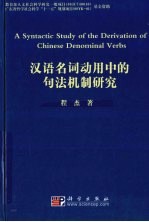图书介绍
汉语名词动用中的句法机制研究PDF|Epub|txt|kindle电子书版本网盘下载

- 程杰著 著
- 出版社: 北京:科学出版社
- ISBN:9787030279286
- 出版时间:2010
- 标注页数:337页
- 文件大小:13MB
- 文件页数:356页
- 主题词:汉语-名词-句法-研究
PDF下载
下载说明
汉语名词动用中的句法机制研究PDF格式电子书版下载
下载的文件为RAR压缩包。需要使用解压软件进行解压得到PDF格式图书。建议使用BT下载工具Free Download Manager进行下载,简称FDM(免费,没有广告,支持多平台)。本站资源全部打包为BT种子。所以需要使用专业的BT下载软件进行下载。如BitComet qBittorrent uTorrent等BT下载工具。迅雷目前由于本站不是热门资源。不推荐使用!后期资源热门了。安装了迅雷也可以迅雷进行下载!
(文件页数 要大于 标注页数,上中下等多册电子书除外)
注意:本站所有压缩包均有解压码: 点击下载压缩包解压工具
图书目录
Chapter 1 Introduction1
1.1 Introduction1
1.2 Denominal Verbs in Chinese1
1.2.1 The Criteria2
1.2.2 The Data4
1.2.3 Semantic Properties of DNVs6
1.3 Previous Approaches to DNVs10
1.3.1 The Lexical/Morphological Approach10
1.3.2 The Pragmatic Approach12
1.3.3 The Lexical-semantic Approach16
1.3.4 The Syntactic Approach21
1.3.5 Summary28
1.4 Rationale for This Research and Questions to Be Addressed28
1.5 A Syntactic Approach to Chinese DNVs:An Overview30
Chapter 2 The V-bar Pied-piping Hypothesis37
2.1 Introduction37
2.2 The V-bar Pied-piping Hypothesis38
2.2.1 Dative Shift Under Current Theories on Verb-related Movement39
2.2.2 The V'Reanalysis Hypothesis43
2.2.3 The V-bar Pied-piping Hypothesis48
2.2.4 Licensing V-bar Pied-piping53
2.3 Explaining Some(A)symmetries of Syntactic Domains56
2.4 Explaining Some Natural Word Order Phenomena64
2.4.1 Adjuncts64
2.4.2 Verb Particles66
2.4.3 Extraposition67
2.4.4 Inversion69
2.5 Deriving Compound Verbs in Chinese72
2.5.1 Verb-Directional/-Phase Constructions in Chinese72
2.5.2 Verb-Resultative Constructions in Chinese76
2.5.3 Light Verb Constructions in Chinese82
2.6 Summary88
Chapter 3 Semantic Light Categories in Chinese90
3.1 Introduction90
3.2 Light Verbs:Syntactic vs.Semantic91
3.2.1 The Meanings of Light Verb94
3.2.2 Light Verb v vs.Proto-verbs102
3.2.3 Proto-verbs vs.Canonical Verbs105
3.2.4 Auxiliary Verbs108
3.3 Null Prepositions in Chinese112
3.3.1 Variety and Unselectiveness of Verbal Objects112
3.3.2 The Null Preposition Hypothesis114
3.3.3 Some Consequences121
3.4 Summary130
Chapter 4 Syntactic Derivation of DNVs131
4.1 Introduction131
4.2 Reclassifying DNVs in Chinese132
4.2.1 Aspectual Classes of Verbs133
4.2.2 Aspectual Classes of Chinese DNVs139
4.3 Deriving DNVs via Syntax156
4.3.1 Deriving Sta-DNVs157
4.3.2 Deriving Ach-DNVs161
4.3.3 Deriving Acc-DNVs163
4.3.4 Deriving Act-DNVs170
4.4 Summary174
Chapter 5 Syntax-Induced Properties of DNVs175
5.1 Introduction175
5.2 The Inter-Class Quantitative Asymmetry176
5.3 The Inter-Categorical Asymmetry185
5.4 The Pattern of Aspectual Shift with DNVs190
5.4.1 State-to-Achievement Shift191
5.4.2 Achievement-to-Accomplishment Shift193
5.4.3 Accomplishment-to-Achievement Shift193
5.4.4 Achievement-to-State Shift195
5.4.5 Some Caveats195
5.5 Accomplishment Verbs in Chinese197
5.5.1 The Traditional View197
5.5.2 Object-coerced Accomplishment Verbs198
5.5.3 Syntactically-derived Accomplishment Verbs200
5.6 Determination of the Aktionsart of DNVs202
5.6.1 Definiteness of Objects203
5.6.2 Boundedness of Objects205
5.6.3 Boundedness of Source Nouns209
5.6.4 Proto-verbs210
5.7 Eventuality Structure of DNVs211
5.7.1 The Singular-headedness of Sta-and Act-DNVs212
5.7.2 The Double-headedness of Ach-DNVs212
5.7.3 The Triple-headedness of Acc-DNVs213
5.8 Semantic Generation of DNVs215
5.8.1 The Basics of Generative Lexicon215
5.8.2 Generating the Semantics of Sta-DNVs218
5.8.3 Generating the Semantics of Ach-DNVs221
5.8.4 Generating the Semantics of Acc-DNVs222
5.8.5 Generating the Semantics of Act-DNVs223
5.8.6 Functioning of Proto-verbs225
5.9 Summary227
Chapter 6 A Comparative Perspective on DNVs229
6.1 Introduction229
6.2 Asymmetries Between Chinese and English DNVs230
6.2.1 Quantitative Asymmetry230
6.2.2 Typological Asymmetry231
6.2.3 Aspectual Asymmetry232
6.3 Potential Parametric Variations235
6.3.1 Activity vs. Inertness of Null Preposition P236
6.3.2 Prominence vs. Dormancy of Proto-verbs240
6.3.3 Applicability of V-bar Pied-piping253
6.4 The Account for the Asymmetries261
6.4.1 Explaining the Quantitative Asymmetry261
6.4.2 Explaining the Typological Asymmetry264
6.4.3 Explaining the Aspectual Asymmetry270
6.5 Summary272
Chapter 7 A Diachronic Perspective on Chinese DNVs273
7.1 Introduction273
7.2 Characteristics of Classical Chinese DNVs274
7.3 Light Categories and V-bar Pied-piping in Classical Chinese276
7.3.1 Null Prepositions in Classical Chinese Syntax277
7.3.2 Proto-verbs in Classical Chinese Syntax280
7.3.3 V-bar Pied-piping in Classical Chinese Syntax288
7.3.4 Classical Chinese DNVs:A Paradox292
7.4 A Minimalist Account293
7.4.1 Patterns of Feature Bundling293
7.4.2 Strength of Morphemes295
7.4.3 The Account297
7.5 The Extension of Light Categories from Syntax to Morphology301
7.5.1 The Denominal Prefix*s-in Early Archaic Chinese301
7.5.2 The Denominal Falling Tone in Middle Archaic Chinese303
7.5.3 DenominalLight Categories in Modern Chinese305
7.6 Summary307
Chapter 8 Concluding Remarks309
8.1 Major Findings309
8.2 Limitations312
Appendix314
References327